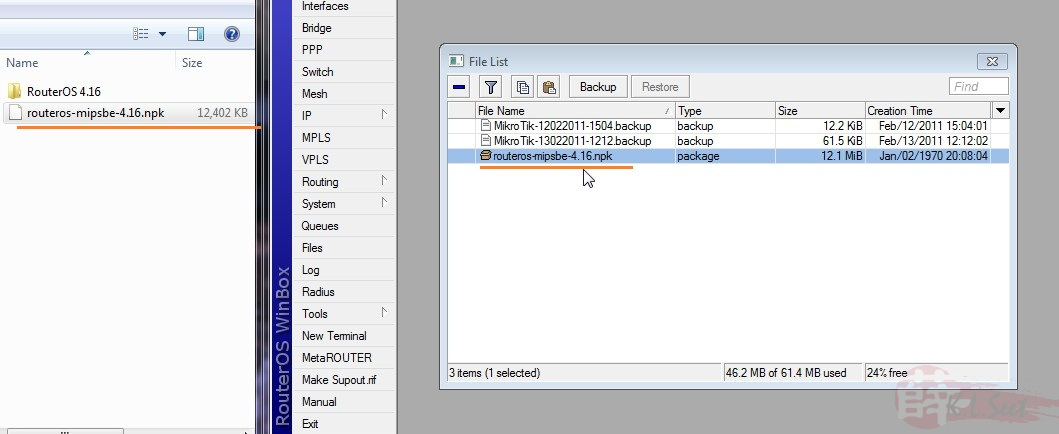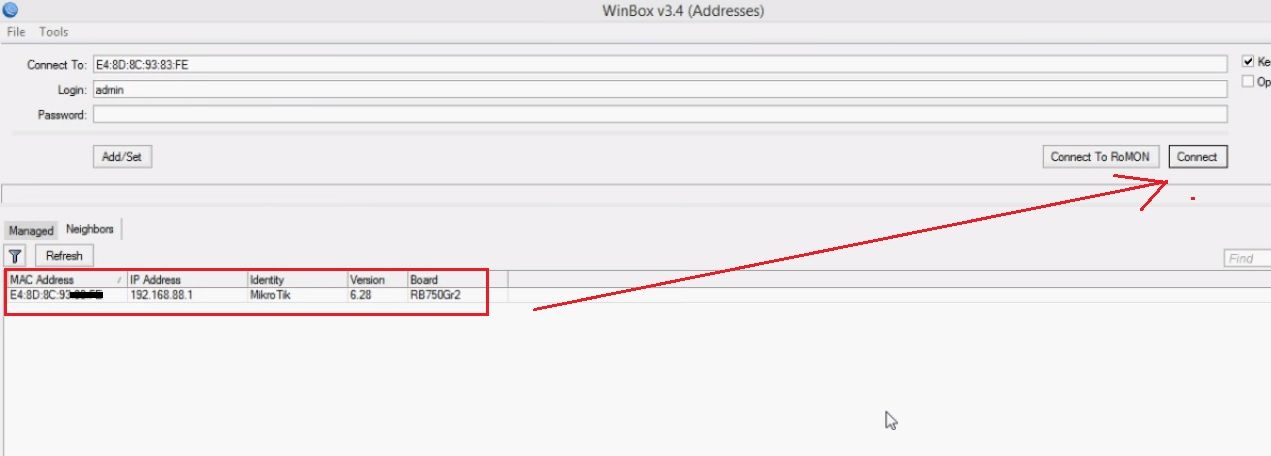Download File Backup Mikrotik Rb750
- See full list on wiki.mikrotik.com.
- System's backup file also contain the device's MAC addresses, which are also restored when the backup file is loaded. Warning: If The Dude and user-manager is installed on the router, then the system backup will not contain configuration from these services, therefore additional care should be taken to save configuration from these services.
- This video Provide How to Backup Mikrotik Router Configuration File.http://www.mikrotikroutersetup.blogspot.com.
Akan membantu juga jika kita mengganti/rename file backup dengan nama yang mudah diingat. Misalnya, “backup router rumah 20-08-14.backup” dan juga tambahkan tanggal file backup itu dibuat. Cara Restore File Backup MikroTik (Binary) Di WinBox klik menu “Files” Jika file backup sudah ada di list file dari backup sebelumnya, klik untuk. File Backup Mikrotik Rb750.epub. Download Mikrotik Routerboard 1100 Configuration Manual: online no charge epub. RouterBOARD - User manuals - MikroTik Documentation Bookmark File PDF Mikrotik Router. Mikrotik rb750 manual pdf Peatix. The following steps will show how to restore MikroTik configuration from backup file using Winbox GUI.
Applies to RouterOS: v6.14 +
Since RouterOS v6.14 MikroTik offers multiple services for your RouterBOARD devices that are connected to the Internet. These services are meant to ease the inconveniences when configuring, setting up, controlling, maintaining or monitoring your device. More detailed list of available services that IP/Cloud can provide can be found below.
Note: Since RouterOS v6.27 'ip cloud enabled' is renamed to 'ip cloud ddns-enabled' this may require some changes in your scripts if you are using this feature in a script.
See Full List On Wiki.mikrotik.com
Note: Since RouterOS v6.43 your device will use cloud2.mikrotik.com to communicate with the MikroTik's Cloud server. Older versions will use cloud.mikrotik.com to communicate with the MikroTik's Cloud server.
Warning: Be aware that if router has multiple public IP addresses and/or multiple internet gateways, the exact IP used for the communicating with the MikroTik's Cloud server may not be as expected!
Note: IP/Cloud requires a working license on Cloud Hosted Router (CHR).
DDNS
DDNS or Dynamic DNS is a service that updates the IPv4 address for A records and the IPv6 address for AAAA records periodically. Such a service is very useful when your ISP has provided a dynamic IP address that changes periodically, but you always need an address that you can use to connect to your device remotely. Below you can find operation details that are relevant to the IP/Cloud's DDNS service:
- Checks for outgoing IP address change: every 60 seconds
- Waits for the MikroTik's Cloud server's response: 15 seconds
- DDNS record TTL: 60 seconds
- Sends encrypted packets to cloud.mikrotik.com or cloud2.mikrotik.com using UDP/15252 port
Since RouterOS v6.43 if your device is able to reach cloud2.mikrotik.com using IPv6, then a DNS AAAA record is going to be created for your public IPv6 address. If your device is only able to reach cloud2.mikrotik.com using IPv4, then only a DNS A record is going to be created for your public IPv4 address.
To enable the DDNS service:
Note: When the service is enable, a DNS name will be stored on the MikroTik's Cloud server permanently and this DNS name will resolve to the last IP that your IP has sent to the MikroTik's Cloud server.
To disable the DDNS service:
Note: As soon as you disable the service, your device sends a command to the MikroTik's Cloud server to remove the stored DNS name.

To manually trigger a DNS update:
Note: To actually connect to the device using the DNS name provided by cloud server, user must configure router's firewall to permit such access from the WAN port. (Default MikroTik configuration does not permit access to services such as WebFig, WinBox etc. from WAN port)

Update time
Correct time on a device is important, it cause issues with the system's logs, break HTTPS connectivity to the device, tunnel connectivity and other issues. To have your system's clock updated, you can use NTP or SNTP, though it requires you to specify an IP address for the NTP Server. In most cases NTP/SNTP is not required in order to simply have a correct time set on the device, for simplicity you can use the IP Cloud's update time service. Below you can find operation details that are relevant to the IP/Cloud's update time service:
- Approximate time (accuracy of several seconds, depends on UDP packet latency)
- Updates time after a reboot and during every DDNS update (when router's WAN IP address changes or after the force-update command is used)
- Sends encrypted packets to cloud.mikrotik.com or cloud2.mikrotik.com using UDP/15252 port
- Detects time-zone depending on the router's public IP address and our commercial database
To enable the time update service:
To enable automatic time zone detection:

Note: If /ip cloud update-time is set to auto, then device's clock will be updated with MikroTik's Cloud server time (if no NTP or SNTP client is enabled).

Backup
Since RouterOS v6.44 it is possible to store your device's backup on MikroTik's Cloud server. The backup service allows you to upload an encrypted backup file, download it and apply the backup file to your device as long as your device is able to reach MikroTik's Cloud server. Below you can find operation details that are relevant to the IP/Cloud's backup service:
- 1 free backup slot for each device
- Allowed backup size: 15MB
- Sends encrypted packets to cloud2.mikrotik.com using UDP/15252 and TCP/15252 port
To create a new backup and upload it the MikroTik's Cloud server:
Note: The create-and-upload action command will create a new system's backup file,encrypt the backup file with AES using the provided password and upload it. For upload action command the password property has no effect since the upload action command uploads only already created system's backup files.
To download the uploaded backup file and save it to device's memory:
Warning: The secret-download-key is a unique identifier that can be used to download your encrypted backup to your other devices. Since you can download your encrypted backup from any location and any device by using the secret-download-key, then you should try to keep this identifier a secret. The downloaded backup is still encrypted using AES, nevertheless make sure you are using a strong password!
To remove the uploaded backup:
To upload an existing backup file (created previously):
Note: Make sure that the backup was encrypted using AES, otherwise the IP/Cloud will reject the backup upload. Since there is only 1 free backup slot per device, then you need to remove the existing backup before uploading a new one.
Warning: When importing a backup all MAC addresses are set to the MAC addresses that the device was using. This is useful when you are replacing a device that has failed, but this might not be desired when applying the same backup on multiple devices since it will set the same MAC addresses on multiple devices, which can cause connectivity issues. You can always use the reset-mac-address command on each interface to set the original MAC address back.
Sub-menu:/ip cloud
| Property | Description |
|---|---|
| ddns-enabled (yes | no; Default: no) | If set to yes, then the device will send an encrypted message to the MikroTik's Cloud server. The server will then decrypt the message and verify that the sender is an authentic MikroTik device. If all is OK, then the MikroTik's Cloud server will create a DDNS record for this device and send a response to the device. Every minute the IP/Cloud service on the router will check if WAN IP address matches the one sent to MikroTik's Cloud server and will send encrypted update to cloud server if IP address changes. |
| ddns-update-interval (time, minimum 60 seconds; Default: none) | If set DDNS will attempt to connect IP Cloud servers at the set interval. If set to none it will continue to internally check IP address update and connect to IP Cloud servers as needed. Useful if IP address used is not on the router itself and thus, cannot be checked as a value internal to the router. |
| update-time (yes | no; Default: yes) | If set to yes then router clock will be set to time, provided by cloud server IF there is no NTP or SNTP client enabled. If set to no, then IP/Cloud service will never update the device's clock. If update-time is set to yes, Clock will be updated even when ddns-enabled is set to no. |
| public-address (read-only: address) | Shows device's IPv4 address that was sent to cloud server. This field is visible only after at least one IP Cloud request was successfully completed. |
| public-address-ivp6 (read-only: address) | Shows device's IPv6 address that was sent to cloud server. This field is visible only after at least one IP Cloud request was successfully completed. |
| warning (read-only: string) | Shows a warning message if IP address sent by the device differs from the IP address in UDP packet header as visible by the MikroTik's Cloud server. Typically this happens if the device is behind NAT. Example: 'DDNS server received request from IP 123.123.123.123 but your local IP was 192.168.88.23; DDNS service might not work' |
| dns-name (read-only: name) | Shows DNS name assigned to the rdevice. Name consists of 12 character serial number appended by .sn.mynetname.net. This field is visible only after at least one ddns-request is successfully completed. |
| status (read-only: string) | Contains text string that describes current dns-service state. The messages are self explanatory
|
Advanced
Sub-menu:/ip cloud advanced
Download File Backup Mikrotik Rb750r2
| Property | Description |
|---|---|
| use-local-address (yes | no; Default: no) | By default, the DNS name will be assigned to the detected public address (from the UDP packet header). If you wish to send your 'local' or 'internal' IP address, then set this to yes |
Cloud backup
Sub-menu:/system backup cloud
Below you can find commands and properties that are relevant to the specific command, other properties will not have any effect.
- download-file
| Property | Description |
|---|---|
| action (download) | Downloads an uploaded backup file from MikroTik's Cloud server. |
| number (integer) | Specifies the backup slot on the MikroTik's Cloud server, the free backup slot is always going to be in the 0th slot. |
| secret-download-key (string) | Unique identifier that can be used to download your uploaded backup file. When downloading the uploaded backup file you do not have to be using the same device, from which the backup was uploaded from. Useful when deploying a backup on a new device. |
- remove-file
| Property | Description |
|---|---|
| number (integer) | Deletes the backup file in the specified backup slot, the free backup slot is always going to be in the 0th slot. |
- upload-file
| Property | Description |
|---|---|
| action (create-and-upload) | Uploads a backup file to the MikroTik's Cloud server.
|
| name (string) | Specifies the backup's name that will show up in the uploaded backups list. This is NOT the source backup's name, this name is only used for visual representation. |
| src-file (file) | Backup's file name to upload that was created using /system backup. This property only has effect when action is set to upload. |
| password (string) | Create, encrypt and upload a backup file with the specified password. This property only has effect when action is set to create-and-upload. |
[Top | Back to Content]